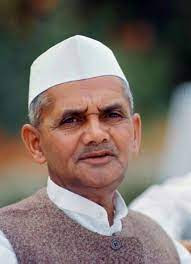Lal Bahadur Shastri (1904-1966)
Lal Bahadur Shastri was an Indian
politician and statesman who served as the second Prime Minister of India from 1964 until his death in 1966. He was born on October 2, 1904, in Mughalsarai, a small town in the present-day state of Uttar Pradesh, India. He played a key role in India's struggle for independence and was a prominent figure in the Indian National Congress.Early Life and Education:
Lal Bahadur Shastri was born to Sharada Prasad and Ramdulari Devi. His father was a school teacher, and Lal Bahadur was the youngest of their three children. He lost his father at a young age, and his mother had to raise him and his siblings on her own.
Shastri was a brilliant student and had a keen interest in literature and politics from a young age. He completed his primary education in Mughalsarai and went on to attend the Kashi Vidyapeeth in Varanasi, where he studied philosophy, ethics, and Sanskrit. He was deeply influenced by the teachings of Mahatma Gandhi and other Indian nationalist leaders.
Role in India's Struggle for Independence:
In 1921, Lal Bahadur Shastri joined the Indian National Congress and became an active participant in India's struggle for independence. He was arrested multiple times for participating in civil disobedience movements and spent a total of seven years in jail.
During his time in jail, Shastri continued to read and educate himself, and he emerged as a prominent leader of the Congress party. He was instrumental in organizing the Salt Satyagraha, a civil disobedience movement against the British salt tax.
In 1947, India gained independence, and Shastri was appointed as the Minister of Police and Transport in the government of Uttar Pradesh. He served in this role until 1951, when he was elected to the Indian Parliament as a member of the Lok Sabha.
Political Career:
Shastri served as the Minister of Railways in the government of Prime Minister Jawaharlal Nehru from 1951 to 1956. During his tenure, he implemented many reforms in the Indian Railways and was widely regarded as one of the best ministers in Nehru's cabinet.
In 1961, Shastri was appointed as the Minister of Home Affairs, where he focused on improving India's internal security and tackling issues related to law and order. He also played a key role in resolving the border dispute with China.
In 1964, after the death of Prime Minister Nehru, Lal Bahadur Shastri was appointed as the Prime Minister of India. His tenure was marked by many challenges, including the Indo-Pakistani War of 1965, which was fought over the disputed territory of Kashmir. Shastri's leadership during the war earned him widespread respect and admiration.
Death and Legacy:
On January 11, 1966, Lal Bahadur Shastri died in Tashkent, Uzbekistan, while on a diplomatic mission to negotiate a peace treaty with Pakistan. The cause of his death remains controversial, with some speculating that he was poisoned.
Despite his short tenure as Prime Minister, Shastri's legacy continues to be celebrated in India. He is remembered as a humble and honest leader who lived a simple life and worked tirelessly for the betterment of his country. His famous slogan "Jai Jawan, Jai Kisan" (Hail the Soldier, Hail the Farmer) continues to inspire and motivate Indians today.















No comments